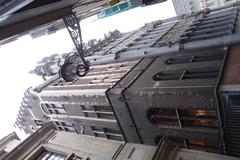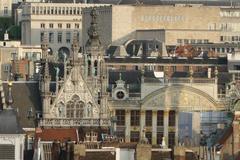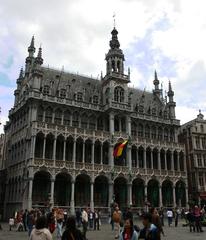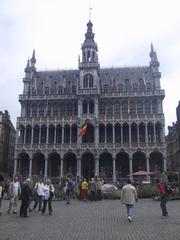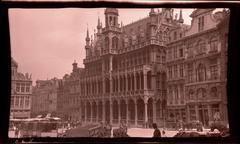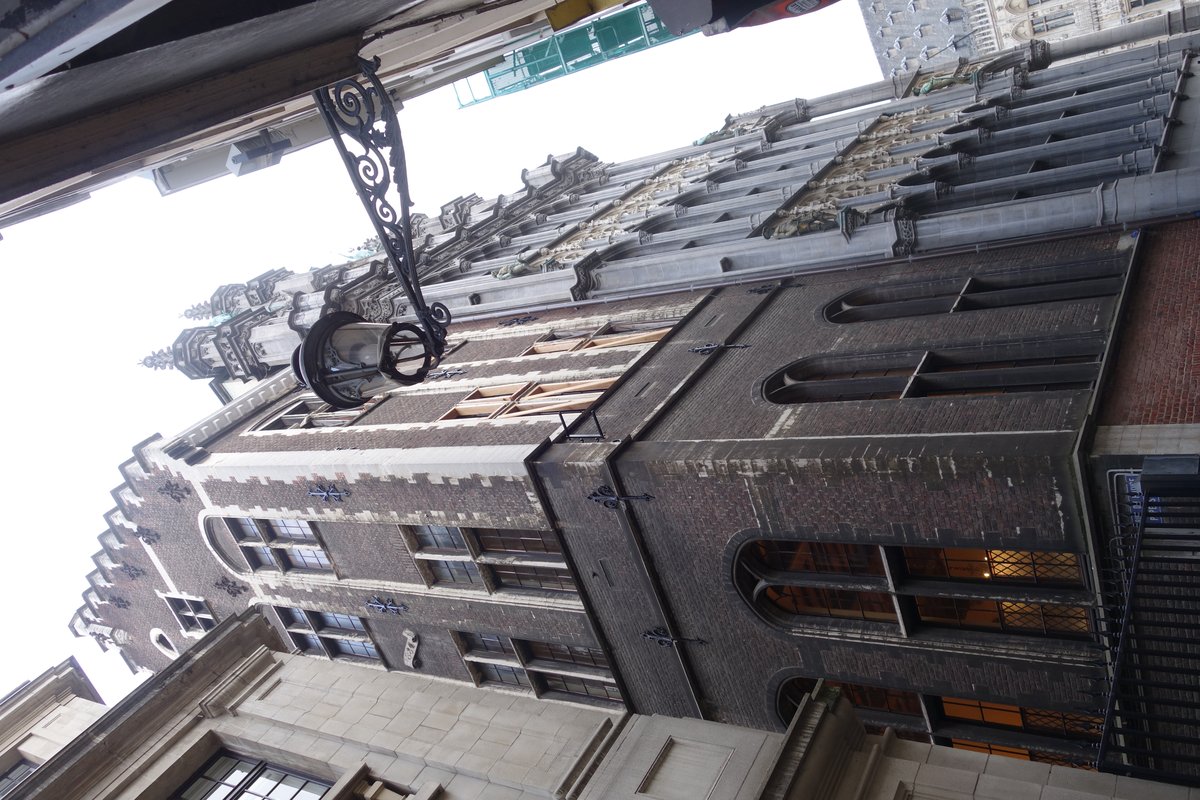
King’s House Visiting Hours, Tickets, and Guide to Historical Sites in Brussels
Date: 15/06/2025
Introduction
At the vibrant heart of Brussels’ UNESCO-listed Grand Place stands the King’s House—known as “Maison du Roi” in French and “Broodhuis” in Dutch. This neo-Gothic marvel, with roots stretching back to the 13th century, is a testament to the city’s layered past and enduring cultural significance. Once a bustling bread market, later a symbol of ducal and royal administration, and now home to the Brussels City Museum, the King’s House invites visitors to explore Brussels’ remarkable journey through history, art, and architecture.
Whether your interests lie in medieval markets, royal intrigue, or architectural splendor, this comprehensive guide covers the King’s House’s visiting hours, ticketing information, accessibility, highlights, and nearby attractions. Use these insights to plan a rewarding visit and immerse yourself in one of Brussels’ most treasured landmarks (Musea Brussels, Visit Brussels, Brussels.info).
Historical Overview
Medieval Beginnings: The Bread Hall
The origins of the King’s House date back to the 13th century, when a wooden hall served as the city’s bread market, giving rise to the Dutch name “Broodhuis” (Musea Brussels). Located on the Grand Place, the hall was central to Brussels’ commercial and social life (Hey Explorer).
Ducal Authority and Stone Transformation
In the 15th century, the Duke of Brabant replaced the wooden hall with a stone structure, asserting ducal power opposite the Town Hall and establishing the site as an administrative center (Visit Brussels).
The Age of Charles V: “Maison du Roi”
The building acquired its French name, “Maison du Roi,” during the reign of Charles V, Holy Roman Emperor. It became the seat of royal representatives and administrative functions, underscored by imperial symbolism like the statue of Charles V and stained glass with imperial coats of arms (Musea Brussels, Brussels City Museum).
Destruction and Neo-Gothic Revival
After suffering damage during 16th- and 17th-century conflicts, the King’s House underwent major restoration in the 19th century under Victor Jamaer. Jamaer’s vision revived its Gothic grandeur while integrating improved construction techniques (Belgium Travel).
Dual Identity and Bilingual Heritage
The building’s two names reflect Brussels’ bilingual culture: “Broodhuis” for its market origins and “Maison du Roi” for its royal-administrative legacy (Lonely Planet).
The Museum Era: Preserving Urban Heritage
Since the late 19th century, the King’s House has been home to the Brussels City Museum. Its vast collection includes artifacts, tapestries, scale models, and the original Manneken Pis statue, providing a window into the city’s evolution (Belgium Travel, Visit Brussels).
UNESCO World Heritage Status
The King’s House, together with the Grand Place, has enjoyed UNESCO World Heritage status since 1998, a recognition of its architectural harmony and historical impact (Hey Explorer).
Architecture and Museum Highlights
Exterior and Facade
The King’s House exemplifies neo-Gothic architecture, with vertical accents, ornate pinnacles, pointed arches, and decorative tracery. Its facade, crafted from local blue limestone, is adorned with statues and allegorical motifs—originals are preserved inside, with replicas outside (visit.brussels, brussels.info). The building’s symmetry and rhythmic window patterns enhance its presence on the Grand Place.
Interior and Collections
Inside, vaulted ceilings evoke a medieval guild hall, while upper floors host galleries chronicling Brussels’ history through paintings, sculptures, artifacts, and decorative arts. Notable features include:
- Ground Floor: Original facade sculptures and medieval artifacts.
- First Floor: Paintings, maps, and models illustrating urban development.
- Second Floor: The original Manneken Pis statue and a vibrant collection of over 1,000 costumes, reflecting a unique Brussels tradition.
Artistic Symbolism
The museum’s artistic details—heraldic shields, painted ceilings, and stained glass—highlight Brussels’ civic and dynastic heritage, enriching the visitor experience (brussels.info).
Visitor Information
Location & Access
Address: Grand Place, 1000 Brussels, Belgium
Telephone: +32 2 279 43 50
Official Museum Website
The museum is centrally located on the Grand Place, directly opposite the Town Hall. The nearest metro and tram stop is Bourse (lines 3 & 4), and several bus lines also serve the area. The Grand Place is pedestrianized, requiring a short walk from public transport stops (Introducing Brussels).
Visiting Hours
- Tuesday to Sunday: 10:00 AM – 5:00 PM
- Closed: Mondays and select holidays (January 1, 5, 11; November 11; December 25).
Tickets and Admission
- Adults: €10
- Seniors (65+): €6
- Students: €4
- Children and youth under 18: Free
- Brussels Card holders: Free
- First Sunday of each month: Free for all
Tickets can be purchased online via the official reservation platform or at the entrance. Group visits require advance reservation.
Accessibility
The ground floor is wheelchair accessible, but upper floors are accessible only by stairs due to the historic structure. Contact the museum in advance for specific arrangements.
Facilities
- Restrooms (a small fee may apply)
- Cloakroom for coats and small bags
- Museum Shop for books and souvenirs
- Audio Guides in multiple languages
- Guided Tours, bookable in advance
Events and Temporary Exhibitions
The museum regularly hosts temporary exhibitions and participates in cultural events such as:
- ZinnekeCity – We are Brussels! (Feb–June 2025)
- Renaissance Day: 15 June 2025
- When balle pelote took over Brussels! (June–Oct 2025)
During the biennial Flower Carpet in August, visitors can access the balcony for panoramic views of the Grand Place and its famous floral display (museum’s news and events page).
Nearby Attractions and Itinerary Suggestions
Explore these top sites within walking distance:
- Grand Place: Admire its ornate guildhalls and Town Hall.
- Galeries Royales Saint-Hubert: 18th-century shopping arcade.
- Jeanneke Pis: Playful counterpart to Manneken Pis.
- Manneken Pis: Iconic Brussels statue.
- Brussels Cathedral: Gothic masterpiece.
Suggested itinerary: Combine a tour of the King’s House with a stroll around Grand Place, a visit to Galeries Royales Saint-Hubert, and a stop at Manneken Pis. Consider guided walking tours or chocolate tastings for a complete Brussels experience (FlyAlong).
Practical Tips for Visitors
- Photography: Non-flash photography is allowed in most areas; check signs for restrictions.
- Languages: Information available in French, Dutch, English, and more.
- Cafés: Sample Belgian dishes at nearby restaurants such as La Roue d’Or.
- Shopping: Browse souvenirs at Galeries Royales Saint-Hubert.
- Security: Be vigilant for pickpockets in crowded areas.
- Wi-Fi: Free Wi-Fi in parts of the Grand Place and the museum.
Accessibility for Families
- Free admission for children under 18.
- Manneken Pis costume exhibits are especially engaging for young visitors.
- While cobblestones outside may pose a challenge for strollers, the museum is generally family-friendly.
Frequently Asked Questions (FAQ)
Q: What are the opening hours?
A: Tuesday to Sunday, 10:00 AM–5:00 PM. Closed on Mondays and certain holidays.
Q: How much are tickets?
A: Adults €10; discounts for seniors, students, and free for under 18s.
Q: Is the museum accessible for wheelchairs?
A: The ground floor is accessible; upper floors are accessible only by stairs.
Q: Are guided tours available?
A: Yes, in multiple languages. Book in advance for best availability.
Q: What attractions are nearby?
A: Grand Place, Town Hall, Manneken Pis, Galeries Royales Saint-Hubert.
Visuals and Media
See high-quality images and virtual tours via the official museum site. Use SEO-optimized alt tags such as “King’s House Brussels facade” and “Manneken Pis costume collection” for your own media.
Conclusion
The King’s House is not only an architectural wonder but also a living chronicle of Brussels’ rich history and culture. Its dynamic exhibitions, central location, and role in city traditions make it a must-visit destination. Plan ahead by checking visiting hours and ticket options, and enrich your visit with guided tours or by exploring nearby attractions.
For more insights and travel inspiration, download the Audiala app, follow us on social media, and stay connected with Brussels’ vibrant heritage.
